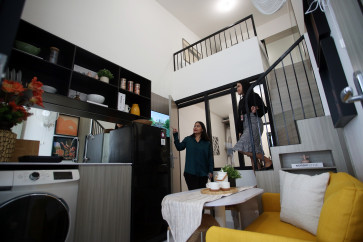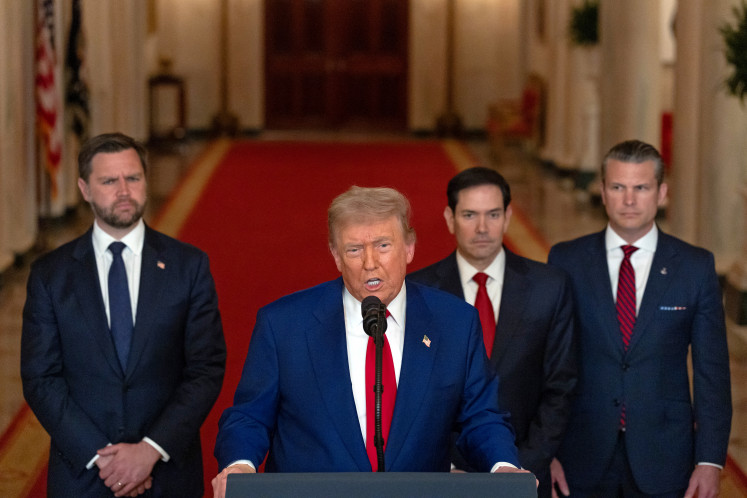Popular Reads
Top Results
Can't find what you're looking for?
View all search resultsPopular Reads
Top Results
Can't find what you're looking for?
View all search resultsOn the wings of an eagle
Carving Master: Having sculpted for three of Indonesia’s presidents, Made Ada’s works, like this Garuda and Hindu God Vishnu, can also be found in Russia’s The State Hermitage Museum and The Kremlin
Change text size
Gift Premium Articles
to Anyone

Carving Master: Having sculpted for three of Indonesia’s presidents, Made Ada’s works, like this Garuda and Hindu God Vishnu, can also be found in Russia’s The State Hermitage Museum and The Kremlin.
Villagers in Pakudui, Gianyar, dedicate their time and craftsmanship to create sculptures of Garuda.
Built as powerfully as the tree trunk he is in the process of sculpting, Nyoman Lamun carefully carves Princess Sita nestled in the wings of a Garuda. With each chisel tap, the royal princess of the Ramayana Hindu epic is further exposed.
Nyoman is one of hundreds of sculptors living in Pakudui village, just north of the Ceking rice fields, who carve the history of the mythological eagle in Ramayana, Garuda; the national symbol.
So important is sculpting Garuda to this hamlet in the hills above Ubud that 90 percent of its inhabitants are employed in the craft. Some residents carve, some sand, polish and or paint the finished carvings of Garuda, Rama, Sita and Vishnu. People in the village are dependent on the sculpture work.

Infinite patience: Little by little, sculptor Nyoman Lamun chisels free the great Garuda eagle, Indonesia's national emblem, and the winged chariot of Vishnu.
A man of few words, Lamun says he, along with most men in the area, learned to carve back in the early 1980s under the tutelage of maestro sculptor and fellow villager, I Made Ada. The community began to carve Garuda following a visit to Pakudui by then president Soeharto.
The works of 67-year old Ada have been collected by three Indonesian presidents and can be seen in the State Hermitage Museum in St. Petersburg and the Kremlin in Russia.
“Soeharto was here in 1981. He ordered more than 100 Garuda statues for the palaces. I taught 75 villagers to sculpt in order to complete the works for Soeharto,” Ada said.
In recognition of the order, Pakudui was renamed Garuda Pakudui in the early 1980s. Three decades later, the village was renamed Garuda Pakudui Tourism Village.
“So now we are officially a tourist village. People trek through the Ceking rice field en route to Tirta Empul in Tampak Siring, passing through Pakudui,” Ada said during an interview at his museum-cum-gallery.
The museum was built 16 years ago on the advice of former president Megawati Soekarnoputri, who ordered a pair of Garuda statues as a gift. At that time, she had been serving as the vice president to Abdurrahman Wahid.
“In 2000, Ibu Mega ordered two statues to take to Vladimir Putin and for The State Hermitage Museum. She wanted Balinese statues to be housed in The Hermitage to promote Indonesia in Russia,” Ada said, explaining that Megawati had also thought it a good idea that his work have a permanent home in Pakudui.
“She advised me to keep some of my works, not to sell everything, because my sculptures are an important part of Balinese art and culture. That is why I built this museum,” he said.
Ada said his family was no stranger to Megawati. His father, I Nyoman Kampih, had worked as a sculptor for her father, Sukarno, one of the country’s founding fathers.
“My father knew Sukarno. He was a collector who had my father’s works in the palace, so Ibu Mega knew of me from her father. She knew we were a family of carvers,” Ada said.
He recounted his brief encounter with Sukarno when he was a child.
“He passed by me at the temple, patted me on the head and asked if I was cold after bathing at the Tirta Empul [water temple]. He had his baton under one arm, as he always did,” he said.
Ada and the villagers crafted Garuda from various timbers, including teak, jackfruit and sawo or sapodilla. Often more than 3-meters-tall, the works are both an expression of the power of Garuda and the breathtaking skill of the artisans of the village.
With his newly sharpened chisel, Lamun, whittles away filament thin shavings as he works on the Garuda and Sita sculpture. It may take three sculptors almost two years to trim, form and sand the epic characters hidden within the grain.
Perhaps the artisans of Garuda Pakudui Tourism Village, with their patience and adherence to Balinese traditions, are as heroic as the great eagle they carve.
— Photos by J.B.Djwan









